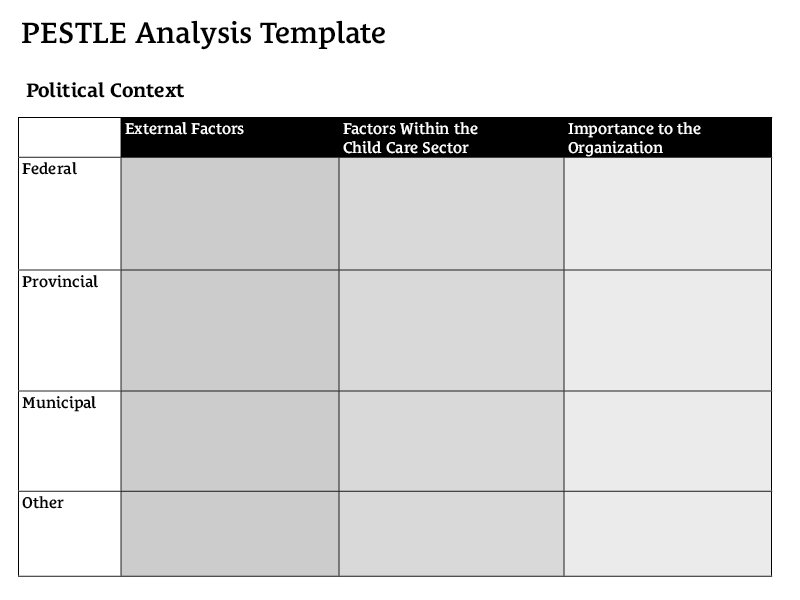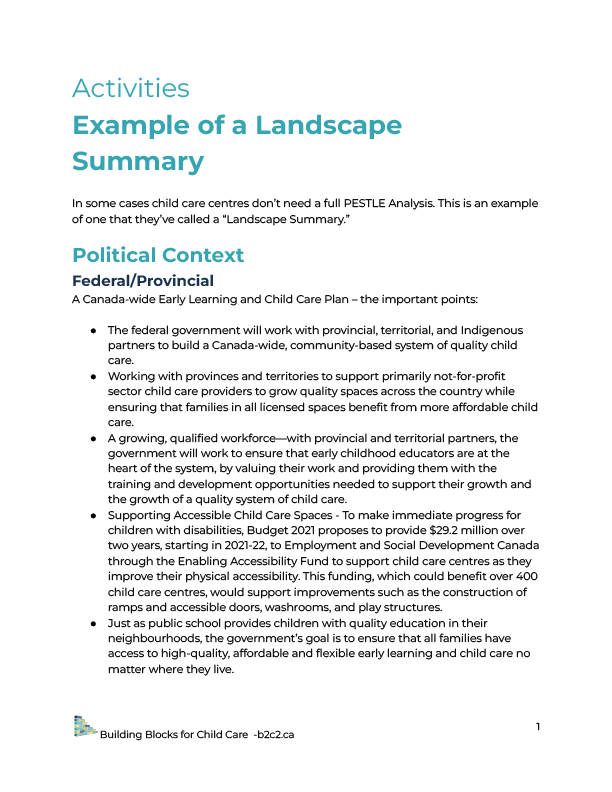Knowing the environment you are working in and the direction of potential shifts will help you understand potential risks associated with your expansion project. Your information gathering should identify both internal and external factors that influence your organization or a particular project. Before writing a strategic plan you need to determine:
Demonstrating that your organization has well grounded financial practices and is financially ready to take on an expansion project is an important consideration for any current or potential funders.
In terms of financial stability – together with your Board ask yourself:
Part of the information gathering within your organization will include determining how an expansion project will be managed, including the role of the board and Executive Director/designate in decision making.
Some things to consider when determining how the project will be managed include:
The way that licensed child care in Canada is funded has dramatically shifted with the introduction of the Canada-wide Early Learning and Child Care (CWELCC) system. Each province and territory (excluding Quebec) have agreements and action plans in place for how CWELCC will be rolled out to the year 2026. Families will pay on average $10/day by 2026.
In Ontario, unlike other provinces and territories, the government designates local governments as the Service System Manager (SSM) for early years and child care services and flows funding to them, who then direct it to service providers.
The Ministry of Education has provided each SSM with “directed growth” targets as and targets for non-profit spaces created.
There are 47 SSM’s in Ontario who play a central role in the planning, funding, administration and operation within each of their service areas. They are required to engage in system-wide planning and setting strategic priorities for the coming years. How each SSM plans to meet their provincially directed growth targets and non-profit proportions will be embedded in their plans.
As a non-profit child care organization, your relationship with the SSM is of utmost importance. Not only are they your key funder, they also decide if you will get CWELCC funding or any other available funding for any kind of expansion. Therefore the information included in their service system plan and alignment with your organization’s concept will be key to your decision about your expansion plans.
A PESTLE analysis studies the key external factors (Political, Economic, Sociological, Technological, Legal and Environmental) that influence an organisation.

A PESTLE analysis studies the key external factors (Political, Economic, Sociological, Technological, Legal and Environmental) that influence an organisation.

In some cases child care centres don’t need a full PESTLE Analysis. This is an example of the types and level of information used before briefing the board of directors and creating a strategic plan.
Knowing the environment you are working in and the direction of potential shifts will help you understand potential risks associated with your expansion project. Your information gathering should identify both internal and external factors that influence your organization or a particular project. Before writing a strategic plan you need to determine:
Using this information, conduct a risk assessment to identify, communicate and develop mitigation strategies for potential risks associated with expansion. Together with your board do a SWOT analysis. Use the tips below to assess if you are informed and ready to move forward.
Demonstrating that your organization has well grounded financial practices and is financially ready to take on an expansion project is an important consideration for any current or potential funders.
In terms of financial stability – together with your Board ask yourself:
Part the information gathering within your organization will include determining how an expansion project will be managed, including the role of the board and Executive Director/designate in decision making.
Some things to consider when determining how the project will be managed include:
The way that licensed child care in Canada is funded has dramatically shifted with the introduction of the Canada-wide Early Learning and Child Care (CWELCC) system. The federal government now provides system level policy and significant funding to reduce fees, expand access and inclusion and increase quality in partnership with the provinces, territories and indigenous communities across Canada. Each province and territory (excluding Quebec) have agreements and action plans in place for how CWELCC will be rolled out to the year 2026.
Prior to the introduction of CWELCC, the child care system was primarily funded through parent fees. This has changed significantly as public funding now replaces parent fees as the main funding source. This is good news for families who will pay on average $10/day by 2026. It is also good news for licensed child care programs who are enrolled in CWELCC as it provides a steady and dependable source of income.
In December 2022, Bill 35 was introduced to parliament. If passed, it is in 3rd reading, the bill would enshrine the principles of a Canada-wide early learning and child care system into federal law. This would include a commitment to maintain federal funding for provinces, territories and Indigenous peoples to support the provision of early learning and child care under a Canada-wide system. However with a change in Government it is uncertain what changes could take place.
The next Federal election will be held on October 20, 2025
Funding under the Ontario – Canada-Wide Early Learning and Child Care (CWELCC) Agreement aims to increase quality, accessibility, affordability, and inclusivity in early learning and child care in the following ways;
In Ontario, unlike other provinces and territories, the government designates local governments as the Service System Manager (SSM) for early years and child care services and flows funding to them, who then direct it to service providers.
Ontario through the Ministry of Education has provided each SSM with “directed growth” targets as well as targets regarding the portion of non-profit spaces created. Ontario’s agreement states that the proportion of non-profit licensed child care spaces for children aged 0 to 5 must be maintained at 70% or increased by the end of the CWELCC agreement.
It is unknown what the next phase for expansion will include beyond 2026.
There are 47 SSM’s in Ontario who play a central role in the planning, funding, administration and operation within each of their service areas. In their role they are required to engage in system wide planning for early years and child care programs serving families with children birth to 12 years old. This involves extensive research and analysis, including consultation with a broad range of stakeholders. Based on their findings they set strategic priorities for the coming years. How each SSM plans to meet their provincially directed growth targets and non-profit proportions will be embedded in their plans.
As a non-profit child care organization, your relationship with the SSM is of utmost importance. Not only are they your key funder, they also decide if you will get CWELCC funding or any other available funding for any kind of expansion. Therefore the information included in their service system plan and alignment with your organization’s concept will be key to your decision about your expansion plans.
Support from your SSM and alignment with their priorities
The Government of Ontario has a unit, Infrastructure Ontario, which does provide funding for bricks and mortar to specified public services and businesses but child care is not on the list – we’re now beating the drum to persuade the government that Infrastructure Ontario should be extended to child care.
Find out about child care expansion news, how B2C2 can help you, and everything about child care expansion in Ontario.